12+ Things to Make With Dandelion Flowers
Learn how to use dandelion flowers to make useful things such as: salve, soap, dandelion jelly, and more!
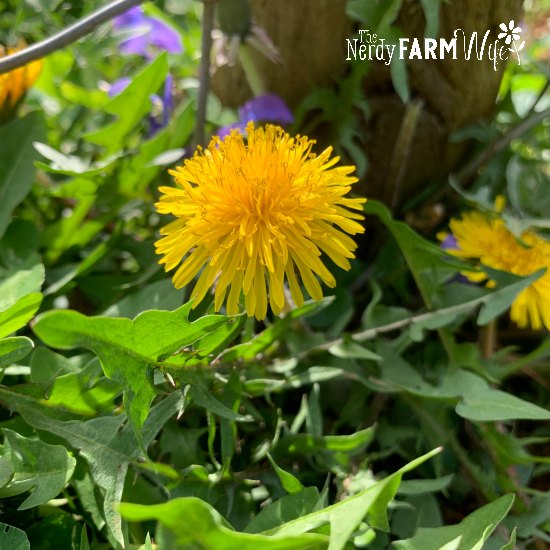
Dandelions are the epitome of cheerful resilience. Though many people inexplicably find them ugly and try to destroy them with harmful herbicides, they’re sunny little drops of happiness that offer a multitude of health benefits and even potential treatment for several types of cancer. (Check out these studies on PubMed for more information.)
The flowers are especially treasured for their mild analgesic (pain-relieving) properties, making them an excellent addition to products designed for sore muscles or other external aches and pains. They’re also traditionally used in preparations to heal rough chapped skin.
In this article, we’re going to cover 12+ pretty and practical ways that you can use dandelion flowers to make things that are good and useful for you and your family.
Before we begin – I have a free printable for you! This is a Dandelion Plant Spotlight that contains handy reference information about foraging, harvesting, and using dandelions. Just click on the thumbnail below to open it up and save to your computer.
Note: Dandelions are generally safe for most people, but if you have active gallstones, are on diuretics, are pregnant, nursing or on medication, check with a health care provider before consuming internally. If you’re allergic to dandelions, don’t use these recipes.
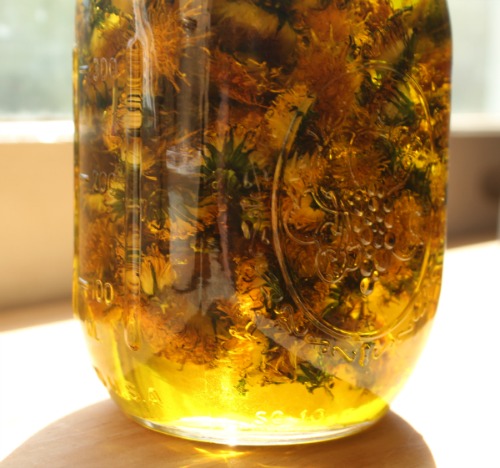
1. Dandelion Flower Infused Oil
Dandelion flower infused oil is often used in recipes designed to soothe and heal chapped or cracked skin. It’s also helpful for sore muscles and other aches and pains. Shelf life of strained dandelion oil is around 1 year.
If you don’t have dandelion flowers where you live, you can occasionally find some for sale on Etsy.
To make dandelion oil:
Fill a canning jar about half-way with dried dandelion flowers. Cover with about twice as much as your favorite carrier oil, or to the top of the jar. (Suggested oils include sunflower, olive, sweet almond, apricot kernel, avocado, or jojoba.)
For a quick oil infusion:
Set the uncovered jar down into a small saucepan filled with a few inches of water. Heat over a low burner for a few hours, keeping a close eye that the water doesn’t evaporate out. Remove from heat and strain. The quick infusion is the best way to infuse coconut oil.
For a slower, more traditional infusion:
Cap the jar of dried dandelion flowers and oil and tuck away in a cabinet for around 4 to 6 weeks, shaking occasionally as you remember to. When the infusing time has passed, strain.
For an alternative option:
You could also set the jar of dandelion flowers and oil in a sunny windowsill so the natural heat from sunshine jump starts the infusion. Infuse for about 2 weeks in a sunny window. (Don’t store for long periods in sunlight though, as it tends to fade flowers and herbs over time.)
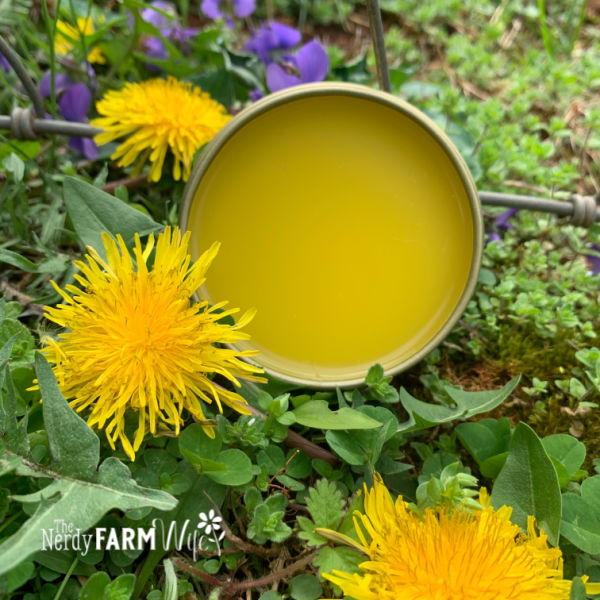
2. Dandelion Flower Salve
Dandelion flower infused oil makes this salve extra soothing for:
- sore muscles
- achy & arthritic joints
- rough, chapped skin
Dandelion salve is especially ideal for those who work outdoors and with their hands a lot!
To make it, you’ll need dandelion infused oil (from #1 above) and beeswax – grated or in pastilles. (For a vegan version, try using half as much candelilla wax in its place.)
Find out (HERE) how to make and use dandelion salve.
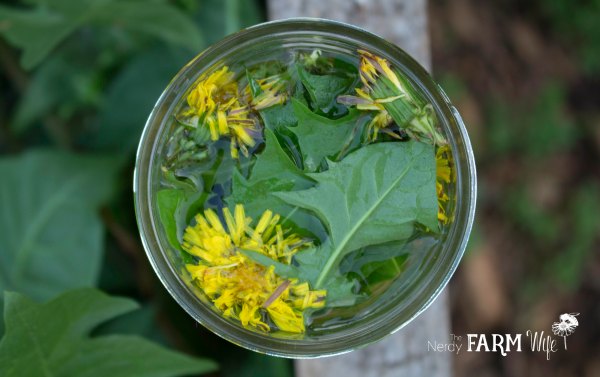
3. Dandelion Vinegar
Dandelions are full of minerals such as calcium, potassium, magnesium and iron and and one of the best ways to extract those is via vinegar.
For this project, you’ll use fresh dandelion flowers mixed with leaves and stems.
To make dandelion vinegar:
Gather fresh dandelion blossoms and leaves, rinse them well, and fill a jar quite full of them, but don’t pack too tightly. Pour apple cider vinegar over the fresh plant matter until the jar is filled.
Cover the top of the jar with wax paper or plastic wrap and then a lid. (This added layer keeps the acidity of the vinegar from eating away at metal lids.)
Place the covered jar in a dark cabinet and store for 4 to 6 weeks, shaking occasionally. Strain and it’s ready to use!
How to use dandelion vinegar:
- dilute with equal parts water and use as a hair rinse
- make an oxymel, or sweet & sour herbal syrup, with it (more about oxymels HERE)
- dilute with water and dab on itchy bug bites
- pour 1 cup of vinegar into a bath along with 1 cup of Epsom salts for achy tired muscles
- make a homemade vinaigrette: Combine 3 tablespoons oil, 2 tablespoons dandelion vinegar, 1 tablespoon crumbled bacon, 1/2 tablespoon chopped onion, 1 teaspoon maple syrup, and salt and pepper to taste. Shake together in a jar and let stand for twenty or thirty minutes so the flavors meld together. Shake again and pour over your salad. Yum! (Use white wine vinegar for a milder taste.)
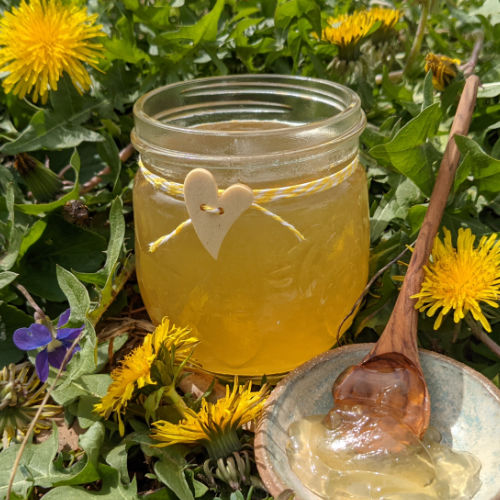
4. Dandelion Jelly
Dandelion Jelly is easy and delicious to make!
This version uses low sugar needed pectin, to reduce the amount of sugar used, compared to traditional recipes.
You can find the recipe over at our family’s website, Unruly Gardening:
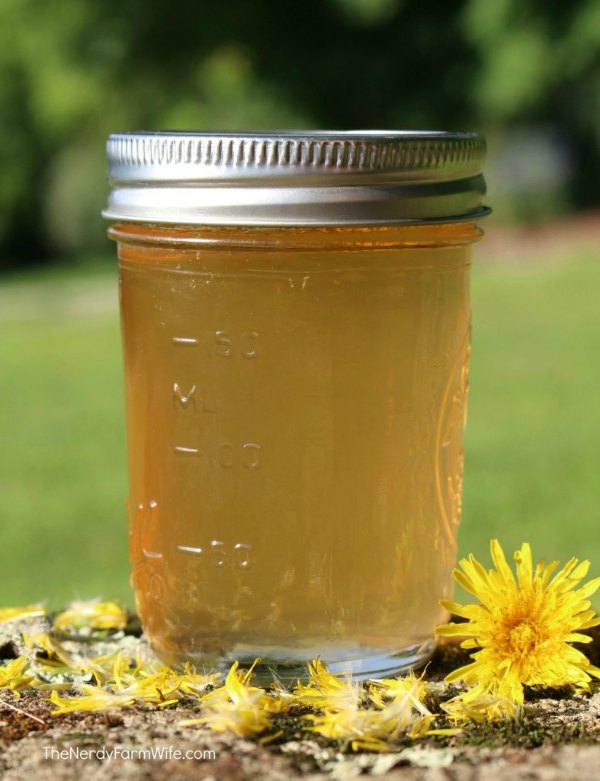
5. Traditional Scandinavian Dandelion Syrup
This tasty way to use dandelion flowers was sent to me by Tina, a lovely reader in Denmark!
She was kind enough to translate and share a few traditional Scandinavian foraging recipes with me, including this one for Dandelion Syrup that she makes each summer.
To make it, you’ll need dandelion flowers, green apples, water, sugar, and lemons. (Optionally, if you have a stick of rhubarb, you can add that too.)
You can find her recipe for traditional Scandinavian dandelion syrup HERE.
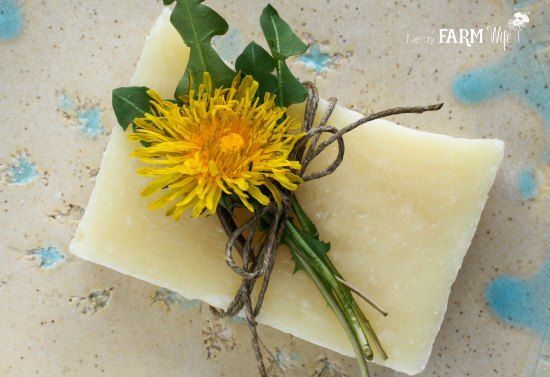
6. Dandelion Soap
I made my first dandelion soap about 16 years ago, wondering what would happen if I put dandelion tea and dandelion oil in my favorite plain soap recipe. I was so happy with the results that I’ve made new variations almost every year since.
Dandelion soap is a perennial favorite among friends and family, and one of my top sellers from when I sold my soaps.
Here are a few of the dandelion soap recipes that I’ve published to date:
- Dandelion Shampoo Bars Recipe
- Dandelion Scrub Bar Soap Recipe
- Handmade Dandelion Soap (crock pot method)
- Honey & Dandelion Soap Recipe
- Dandelion & Honey Liquid Soap Recipe
If you don’t want to make soap from scratch, you could also try this quick and easy Dandelion & Honey Melt & Pour Soap project that uses ready made soap base instead.
For more soap inspiration and recipes, check out my Handmade Natural Soaps eBook package!
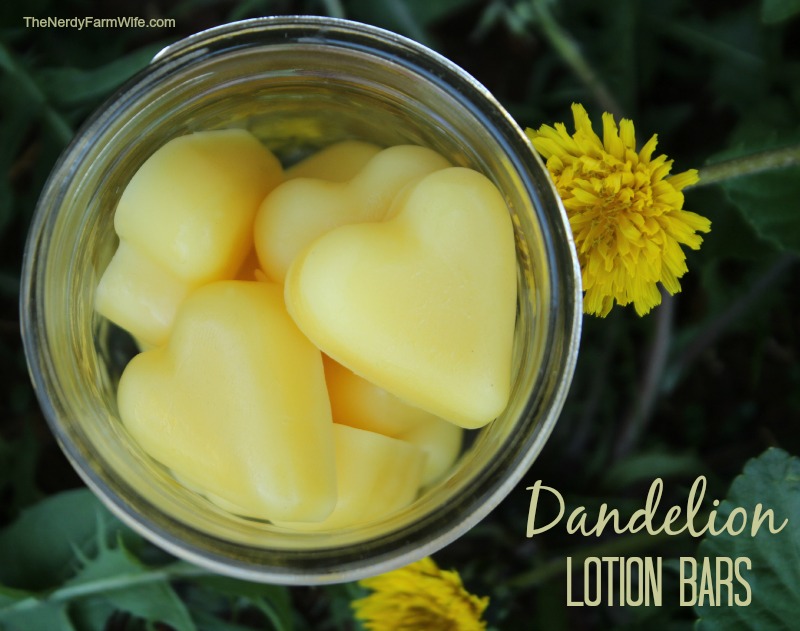
7. Dandelion Lotion Bars
I originally made these lotion bars for my husband. He was a rock mason and the mortar and rough stone left his hands dry, cracked, and bleeding.
Lotion bars have a long history of helping the toughest cases of cracked dry skin, while dandelion oil is particularly useful for alleviating the chapped skin and soreness that comes along with manual labor. This combination is excellent for his skin. He rubs the bar over his hands several times while watching TV each evening. There’s no messy salve to deal with and he can use it on the spots that are most bothering him.
You can find the recipe and directions to make these sweet little dandelion lotion bars HERE.
Below is a video of me making dandelion lotion bars!
(Sometimes an ad plays first, but the video will play right after. If you have an adblocker, you probably won’t see the video section.)
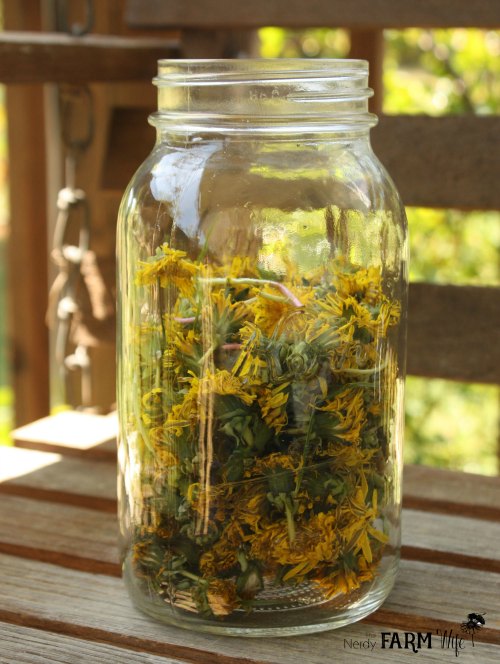
8. Dandelion Tea
Dandelion tea can be made by packing fresh flowers and leaves into a mason jar and pouring simmering water over them. Let the tea infuse until it’s cool enough to drink then strain.
Dandelion tea is a classic spring herbal tonic. It helps purify and detox the blood and and is useful for helping the secondary symptoms of a sluggish system such as acne and constipation.
While dandelion tea can be helpful for some digestive issues, use caution if you have ulcers or chronic health issues and consult a medical professional before using.
Dosage for the tea is one to three cups per day, starting with a low amount and working your way up since it has laxative and diuretic properties your body may need to adjust to.
Dandelion tea can also be used in soap recipes (see above for dandelion soap recipe links.)
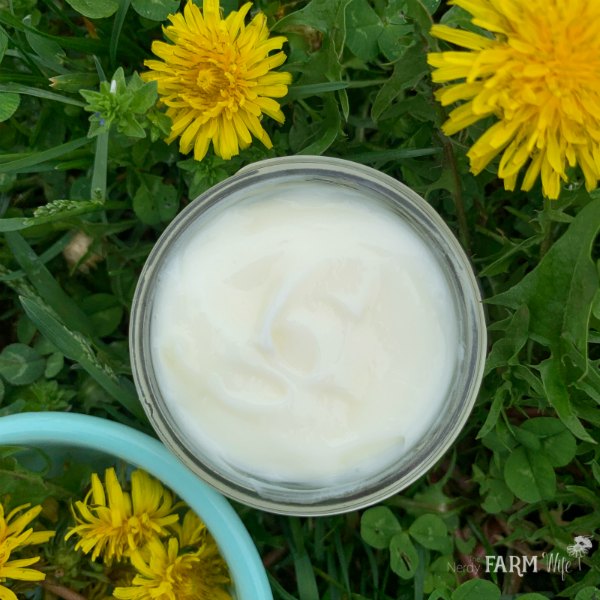
9. Dandelion Magnesium Lotion
I originally designed this recipe for the first edition of my Big Book of Easy Homemade Products book.
It was an instant hit with everyone who tested it, relieving leg cramps, back aches, growing pains, restless leg syndrome and various related ailments. One relative with chronic nerve pain in her arm declared it the best thing I’d ever created!
Dandelion oil and magnesium oil are both wonderful ingredients on their own, but when combined, they have a special synergy that’s amazing!
You can find the full recipe for Dandelion Magnesium Lotion right here on my site (or in my book if you own a copy!)
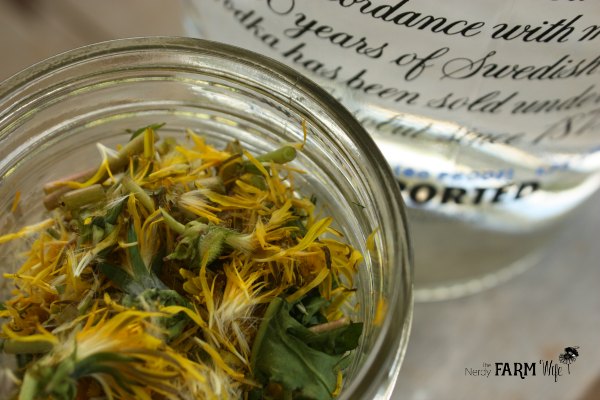
10. Dandelion Tincture
Tinctures are one of the best ways to preserve the benefits of dandelions. While this form does contain alcohol, it’s so concentrated that the end dose is similar to the alcohol content of some cough syrups. The dosage is counted in drops instead of cups. If you don’t consume alcohol, use dandelion vinegar (see #3) for similar properties.
To make a tincture, dig up a dandelion plant – root, leaves, flower, stem… the whole thing! (Or if the root is too difficult to dig up, you can use the leaves, flowers, and stems.)
Rinse it well then chop it as finely as you can. Place the pieces in a mason jar (jar size depends on how much plant you’ve gathered up) then cover with an 80 proof or higher alcohol like vodka. It’s a good idea to keep a layer of plastic wrap or wax paper between the tincture and the lid, if it’s metallic. Cap and store in a cool dark place for 2 to 3 weeks before straining, making sure you shake the jar every so often.
While traditional herbalists recommend a dosage of up to 30 to 40 drops, three or four times per day, I dose my family in much smaller amounts, never more than 4 or 5 drops at a time. (Tinctures are powerful things!) Use this tincture to help with constipation or a sluggish liver that leads to poor digestion and acne.
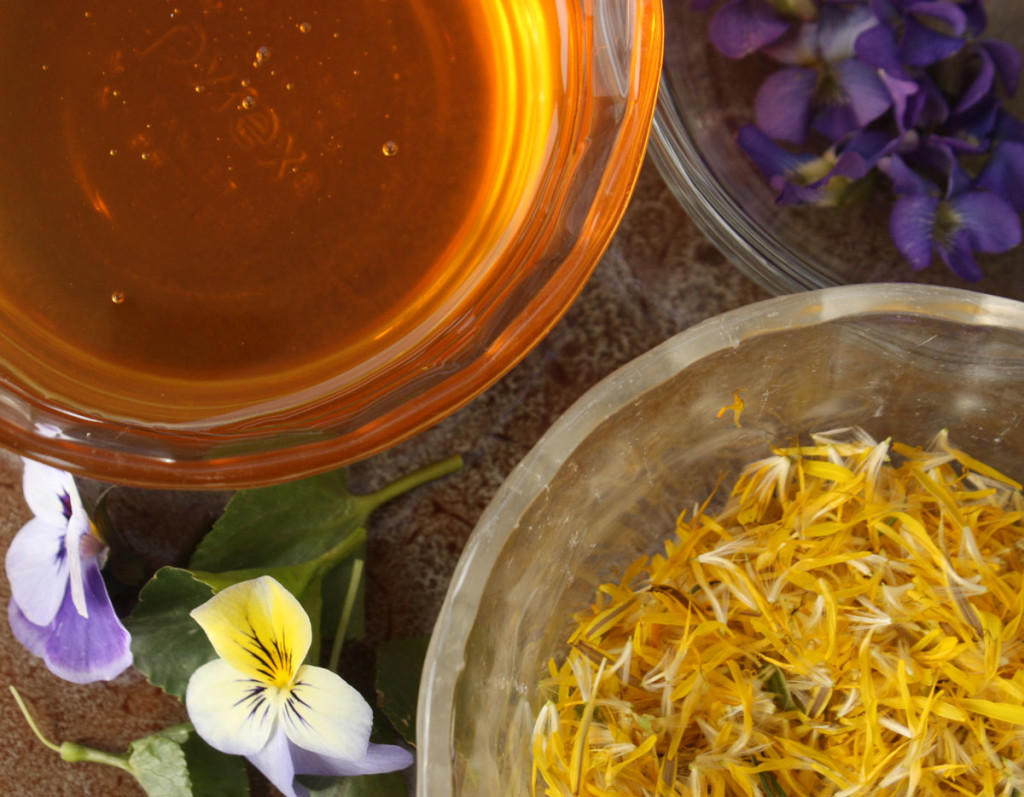
11. Dandelion Infused Honey
Raw honey is a healing food, all on its own. It’s soothing to the throat and GI tract, inhibits the growth of H. pylori (that nasty organism associated with ulcers), it can be used on the skin for acne, burns or diabetic ulcers, and daily use of raw, local honey may help seasonal allergies.
The entire dandelion plant is edible and is a classic liver tonic. It’s traditionally used for joint pain, eczema and as a blood toner and mild diuretic. Dandelion root extract is even being researched for it’s cancer fighting abilities!
The flowers are high in vitamin C, beta carotene and other nutrients.
We’re going to combine these two powerhouses and make a super charged honey!
To make dandelion infused honey:
You’ll need fresh dandelions and some raw honey.
- Remove the green from the dandelions so that you have just the yellow petals. (Some bits of green might remain, that’s okay.)
- Now, stuff these flowers into a small jar and slowly pour your raw honey over them.
- Stir with a knife to remove air bubbles.
- Let this sit in a cupboard for several days to allow the flowers to infuse into the honey.
- Once sufficient time has passed, you can strain the flowers from the honey by slightly heating the mixture (don’t go above 110 degrees F or the benefits of raw honey is negated) then straining through cheesecloth or a mesh strainer.
- Alternatively, you can do what I do and just leave the flowers in and spoon around them.
- You can actually eat the honeyed flowers by the spoonful too. I find them quite yummy!
The shelf life of this honey (strained) is at around a year (or longer), but if you don’t strain the flowers be sure to check for freshness each time before consuming.
Take one to two tablespoons daily to possibly help with seasonal allergies and as a general health tonic. It’s also useful for sore throats, burns and as a face wash.
Dandelion is safe for most people but is not recommended internally if you have active gallstones or are on a prescription diuretic. Also, the American Academy of Pediatrics does not recommend honey for children under the age of one.
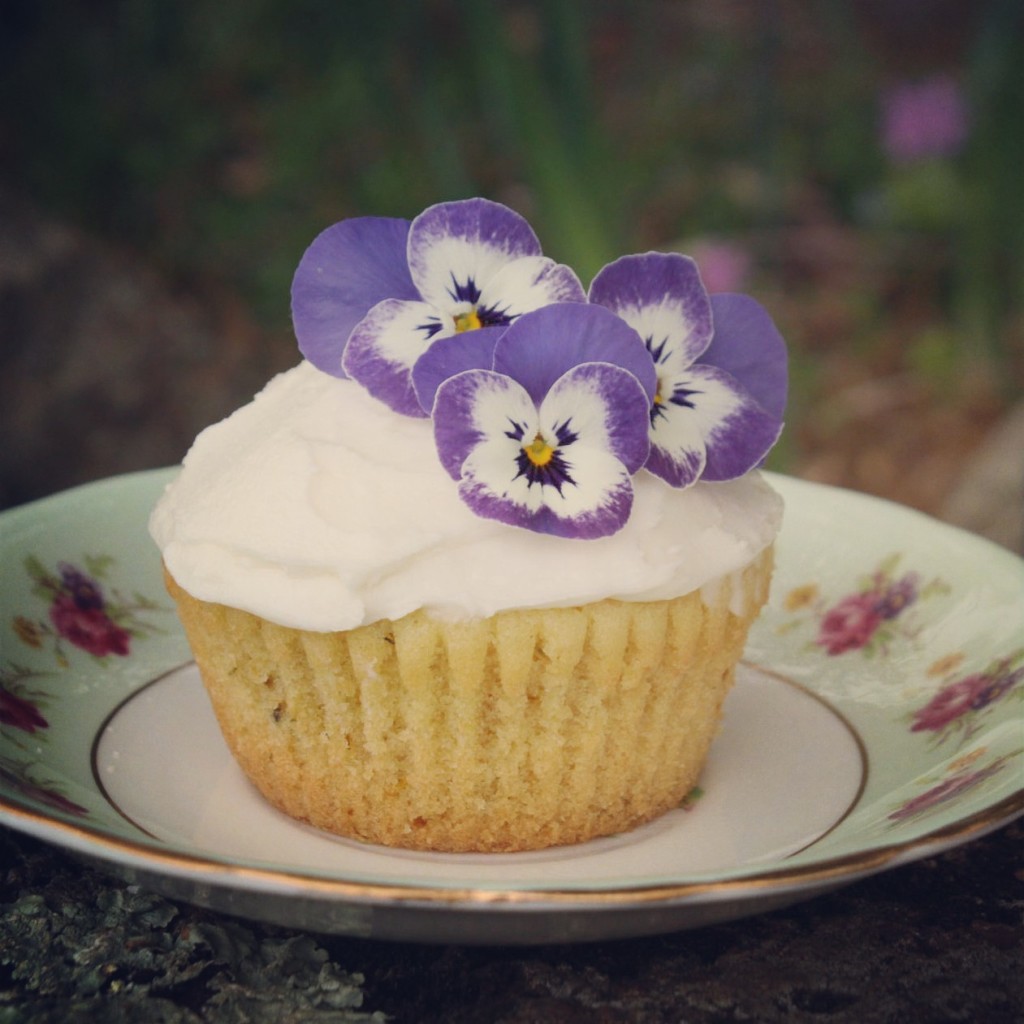
12. Dandelion Cupcakes
Pick a handful or two of dandelions then wash and dry them thoroughly. Pull off just the yellow petals (the green has a stronger bitter taste you don’t really want in a cupcake.)
Mix up your favorite cupcake recipe, stir in the yellow petals, then bake like normal.
Let cool, frost and add an edible flower or two on top for decoration. Some flower ideas for topping: pansies, violets, violas, dianthus, lilac, bachelor buttons, hollyhocks and roses.
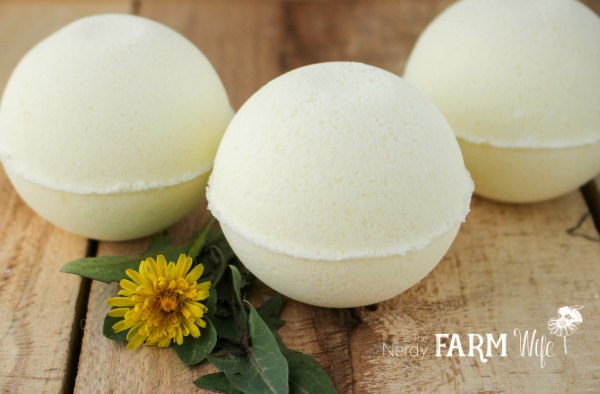
13. Dandelion Bath Bombs
These all natural bath bombs capture the sunshiny happiness of a field full of spring dandelions.
A few drops of sea buckthorn oil gives them a pretty yellow color, but you could also add a small amount of yellow Brazilian clay for a different shade of yellow.
The cheerful scent comes from a blend of litsea and orange (or lemon) essential oils, but you could change out the essential oils (lavender is another good option) or leave them unscented if you’d like.
Find the full recipe for Dandelion Bath Bombs and how to make them HERE.
For more natural bath soak and bath bomb ideas, be sure to check out my Natural Bath Care Package!



Love this article and as i suffer with Arthritis and very dry skin on my hands and fingers I will be having a go at the Dandelion Flower salve and also the soap. Thank you for sharing.
Hi Adena! Happy to hear you enjoyed the article! I hope that the dandelion salve helps your hands!
Love all of your dandelion recipes! When I tell people that the dandelion is my favorite flower, they look at me and laugh, thinking I am joking. I am not! I especially want to try the lotion bars and the homemade dandelion soap. I make homemade soap, but have not tried dandelion soap.
Hi Sue! I’m so glad that you like the recipes! Dandelions are among my top favorite flowers too. :) I hope you enjoy the dandelion lotion bars & soap!
I have always loved dandelions. I like all the ideas how to use them. The medicinal purposes are wonderful.
I would like to know how o make the dandelions under glass.
Hi Ruth! I’ve always wanted to learn how to make them under glass too! They look so beautiful that way. :)
Great! I am just starting to learn about wild Herbs and want to learn more about Danelions and the many thing they can be used for. Thank you for your exciting recipes!
Hi Shirley! I’m so happy you like the dandelion recipes! I hope you enjoy making fun products with your wild herbs! :)
I already make and LOVE magnesium lotion, so I’m definitely going to make some dandelion oil to mix with my lotion! Thanks for the great ideas!!
Hi Brookelyn, I hope you enjoy the combination! It’s one of my favorites! :)
I am so thrilled and excited I found your blog on how to make dandelion flower salve. Great timing too since I have 4 acres of this beautiful flowers. I will head out today after work and start picking. Can’t wait to try this on my arthritic toe. I’m a runner (short distances) and will apply it to my feet after a run. Thank you so much for the recipe and keep your recipes coming. I love love what you do for us!
Hi Ellen, How amazing to have 4 acres of dandelions! I’m happy to hear that you like the recipes & hope that you find the salve helps your toe!
Hi Jan,
Our family has always had a huge garden…..think 120 tomato plants, many peck baskets of corn, peas, beans, etc. But this year, we expanded to maple syrup and lawn flowers like clover, chamomile, and dandelion. We love ramps from woods. Berries in woods have died, but mushrooms are good.
Foraging is fun and learning more each day. Thank you for the info. Chris
That sounds awesome!! So glad you enjoy the info! ?
Hi Jan, I’ve been trying to make slow method infused dandelion olive oil with no success. It gets moldy in the jar ! Please help since I have access to dandelions only now and every time I try this happens. The flowers are not wet, but should I still dry them maybe first? Thank you!
Hi Ana! I definitely recommend completely drying the flowers first since pockets of moisture in the oil are the perfect place for bacteria and mold to grow. In the past, I only wilted the flowers overnight, but ran into the same problem with mold a few times. I think if you use totally dried flowers for your next batch, you’ll have much better luck with your oil. :)
How do i make the dandelion oil
Hi Christine! If you look under #1 in the list above, I have a few different methods of making dandelion oil listed. :)
I sell dried dandelions on Etsy for your recipes. Botanicallampshades.etsy.com
Hi Jennifer, That’s wonderful! Thanks for letting us know! :)
I really enjoyed reading this, especially the recipe for the salve for arthritis pain.
Do you think I could add St. John’s Wort Oil to this formula to kick up the pain remedy feature?
Thank you!
Diana
Hi Diana, Yes, St. John’s Wort Oil would be a great addition to the dandelion salve! :)
Really enjoyed this article. A novice herbalist, life long plant professional, your article is a joyful entry into my materia medica, providing many wonderful ideas for my solar infused almond / dandelion oil. Excellent, clear, attractive presentation. Thank you. Looking forward to exploring other herbal allies with you.
Hi Trisha, Thanks for the kind words! I’m so happy you enjoyed the article!
Does the dried dandelion leaf give the same effect or does it need to be the flower?
Hi Debra! For topical salves & such, the flower is preferred, though I do mix some stems and leaves in every so often too.
“Dandelions are the epitome of cheerful resilience”
I came online to do some research on Dandelions, because I tried the petals in a salad for the first time this week. I was surprised at the light, sweet, tea like taste, given the robustness of Dandelion greens. You really captured things with this statement! It’s going to stick with me! Thanks for sharing the thought and this post
Can you use the dandelion when it’s turned white or only yellow?
What if it’s yellow but closed?
Thank you!
Hi Cara Jean! It’s best to pick the flowers when they’re open and yellow, or if they’re closed and in bud stage, you could throw some of them in there too. Sometimes they turn puffy when you dry them and that’s okay to use them, but you wouldn’t want to pick a puffy white one specifically to infuse in oil. Just save those to help reseed the area for more dandelions next year! :)
In an old cookbook that came from my great grandmother is a recipe for dandelion wine, you have to pick 5 gallons of buds to make it and that takes too long for me to want to do.
Hi Terri! What a lovely treasure to have a cookbook from your great grandmother! It definitely sounds labor intensive – that’s a lot of dandelions! :)
Wondering if you know how I could make this dandelion soap using beef fat? Wouldn’t have to be all beef fat, I just like using it to make soap and have a lot I need to use.
Hi Tessa! You could definitely make dandelion soap with rendered beef fat (tallow). One idea is to use a basic recipe (this one is from my Simple & Natural Soapmaking print book) and just infuse the olive oil with dandelions (or herbs of your choice) and/or make a dandelion tea and chill for the lye solution:
PALM-FREE SOAP #1: TALLOW/LARD VERSION
8.75 oz (248 g) distilled water or liquid of choice
3.9 oz (111 g) sodium hydroxide (lye)
6.5 oz (184 g) coconut oil (23.2%)
4 oz (113 g) lard or tallow (14.3%)
12 oz (340 g) olive oil (42.9%)
2 oz (57 g) castor oil (7.1%)
3.5 oz (99 g) sunflower or sweet almond oil (12.5%)
1.06 to 1.23 oz (30 to 35 g) essential oil of your choice (optional)
Or, if you already have a favorite recipe that you like – just use dandelion infused oil and dandelion tea and you will create your own dandelion soap recipe! :)
Hi Jan,
First off, I want to say that I am super happy I found your blog. I subscribed right away and I can’t wait to try a bunch of your natural recipes.
I went and picked dandelions to make the dandelion and whipped coconut oil lotion you have here on your blog, and when I put the dandelions outside to rest to get rid of the bugs, all the dandelions closed pretty tightly. I brought them in and they are drying now, but will I still be able to infuse the closed (ish) buds in oil, or will I need to go pick some more? Also, if I cannot use them, how do I keep the dandelions from closing?
Thanks so much in advance!
Cherelle from The Inspired Prairie
Hi Cherelle! Thanks for subscribing! :) The dandelions will do that sometimes (and sometimes some will turn to fluff) – as long as they’re nice and dry when you infuse them, they should be fine to use no matter which stage they’re in! :)
Hello Jan, I am new at drying dandelions. How long does it take to air dry them?
Hi Elisabeth! That depends somewhat on where you’re drying them – if it’s a warm and dry room, then they’ll dry quicker than a cold or humid room.
I usually allow about 3 days for mine to dry, but I often just keep them on the drying rack or dish towels for a week or longer before I get around to packaging them up.
It’s generally better to give them an extra day or two of dry time, that way you can be certain they’re nice and dry.
Do I have to dry the dandelions before I put them in honey?
Hi Lauralee! I personally don’t dry them first, but some herbalists like to do so. :)